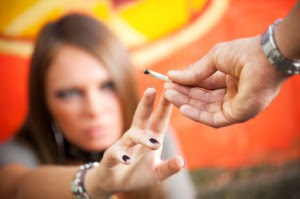Experts in human behavior view drug use and abuse
as just one of the many forms of addictive behavior. Such behavior includes addictions to
shopping, eating, gambling, sex, television, video games, and work, as well as
to alcohol or other drugs.
The process
of Addiction
The process of developing an addiction has been a
much studied topic. Three common aspects
of addictive behavior are exposure, compulsion, and loss of control.
Exposure
As addiction can begin after a person is exposed to
a drug (such as alcohol) or a behavior (such as gambling) that he or she finds
pleasurable. Perhaps this drug or
behavior temporarily replaces an unpleasant feeling or sensation. This initial pleasure gradually, or in some
cases quickly, becomes a focal point in the person’s life.
Compulsion
Increasingly, the person spends more energy, time
and money pursuing the drug use or behavior.
At this point in the addictive process, the person can be said to have a
compulsion for the drug or behavior.
Frequently, repeated exposure to the drug or behavior continues despite
negative consequences, such as gradual loss of family and friends, unpleasant
physical symptoms resulting from taking a drug, or problems at work.
During the compulsion phase, a person’s normal life
often degenerates while he or she searches for increased pleasures from the
drug or the behavior. An addicted
person’s family life, circle or friends, work, or study patterns become less
important than the search for more and better “highs.” The development of tolerance and withdrawal
are distinct possibilities.
Why some people develop compulsions and others do
not is difficult to pinpoint, but addiction might be influenced by genetic
makeup, family dynamics, physiological processes, personality type, peer
groups, and available resources for help.
Loss of
control
Over time, the search for highs changes to a desire
to avoid the effects of withdrawal from the drug or behavior. Addicted people lose their ability to control
their behavior. Despite overwhelming
negative consequences (for example, deterioration of health, alienation of
family and friends, or loss of all financial resources), addicted people
continue to behave in ways that make their lives worse. The person addicted to alcohol continues to
drink heavily, the person addicted to shopping continues to run up heavy debts,
and the person addicted to food continues to eat indiscriminately. This behavior reflects a loss of control over
one’s life. Frequently, a person has
addictions to more than one drug or behavior.
Intervention
and Treatment
The good news for people with addictions is that
help is available. Within the last two
decades, much attention has been focused on intervention and treatment for
addictive behavior. Many people with
drug problems can be helped through programs such as inpatient or outpatient
treatment, family counseling, and long-term aftercare counseling.
It
is common for people in aftercare treatment for addictive behavior to belong to
a self-help support group, such as Alcoholics Anonymous. These groups are often listed in the phone
book or the classified section of the newspaper.














No comments:
Post a Comment